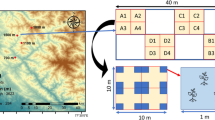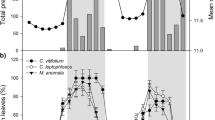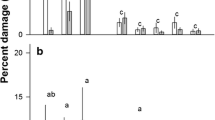Abstract
Different environmental conditions are crucial to determine many attributes in plants by selective pressures. Plant traits and ecological interactions may present variation in outputs in these distinctive selection scenarios. In south Brazil, yerba mate (Ilex paraguariensis A. St.-Hil.) has been cultivated in monoculture and in consortium systems, differing significantly in lightning intensity and associated plant richness. In this study, three areas of both cultivation systems were monitored to verify the plant outputs in leaf area and herbivory damage. Our results showed that consortium system cultivation presents higher values of leaf area and higher damage by herbivory. Higher leaf area in consortium system corresponds to numerous studies and corroborates the phenotypic plasticity expected for Ilex paraguariensis. On the other hand, the higher leaf damage opposed the hypothesis that greater plant richness should promote the best herbivory control by natural enemies. Despite the higher foliar loss plants cultivated under consortium system present adequate leaf area to farmers. Beside species richness, other plant community traits play important role in mitigation of herbivory.



Similar content being viewed by others
References
Beer J, Muscheler R, Kass D, Somarriba E (1997) Shade management in coffee and cacao plantations. Agrofor Syst 38:139–164
Bingham RA, Agrawal AA (2010) Specificity and trade-offs in the induced plant defence of common milkweed Asclepias syriaca to two lepidopteran herbivores. J Ecol 98:1014–1022
Bond BJ, Farnsworth BT, Coulombe RA, Winne WE (1999) Foliage physiology and biochemistry in response to light gradients in conifers with varying shade tolerance. Oecologia 120:183–192
Branco CS, Lima ÉD, Pavão E, Bertholdo-Vargas LR, Barros NM, Salvador M (2014) Araucaria angustifolia (Bert.) O. Kuntze induces oxidative and genotoxic damage in larvae of Anticarsia gemmatalis Hübner (Lepidoptera: Erebidae). Int J Pest Manag 60:114–120
Ceconi DE, Poletto I, Brun EJ, Lovato T (2006) Crescimento de mudas de Açoita-cavalo (Luehea divaricata Mart.) sob influência da adubação fosfatada. Cerne 12:292–299
Chander K, Goyal S, Nandal DP, Kapoor KK (1999) Soil organic matter, microbial biomass and enzyme activities in a tropical agroforestry system. Biol Fert Soils 29:196–200
Cockle KL, Leonard ML, Bodrati AA (2005) Presence and abundance of birds in an Atlantic Rain Forest reserve and adjacent plantation of shade-grown yerba mate, Paraguay. Biodivers Conserv 14:3265–3288
Coelho GC, Mariath JEA (1996) Inflorescences morphology of Ilex L. (Aquifoliaceae) species from Rio Grande do Sul, Brazil. Feddes Repert 107:19–30
Coelho GC, Rachwal MFG, Dedecek RA, Curcio GR, Nietsche K, Schenkel EP (2007) Effect of light intensity on methylxanthine contents of Ilex paraguariensis A, SL. Hil. Biochem Syst Ecol 35:75–80
Eibl B, Fernandez RA, Kozarik JC, Lupi A, Montagnini F, Nozzi D (2000) Agroforestry systems with Ilex paraguariensis (American holly or yerba mate) and native timber trees on small farms in Misiones, Argentina. Agrofor Syst 48:1–8
Fazolin M (1997) Levantamento e análise faunistica de insetos associados às plantas de um modelo de sistema agroflorestal em Rio Branco. Boletim Técnico Embrapa 116:1–13
Fordyce JA (2006) The evolutionary consequences of ecological interactions mediated through phenotypic plasticity. J Exp Biol 209:2377–2383
Futuyma D, Agrawal A (2009) Macroevolution and the biological diversity of plants and herbivores. PNAS 106:18054–18061
Gardiner MM et al (2009) Landscape diversity enhances biological control of an introduced crop pest in the north-central USA. Ecol Appl 19:143–154
Giberti GC (1995) Aspectos oscuros de la cronologia de Ilex paraguariensis St. Hil. In: Erva-mate—Biologia e Cultura no Cone Sul. In: H Winge, AG Ferreira, JEA Mariath, LC Tarasconi (Eds) Editora da Universidade Federal do Rio Grande do Sul, Porto Alegre, pp 289–302
Givnish TJ (1988) Adaption to sun and shade, a whole-plant perspective. Aust J Plant Physiol 15:63–92
Hermes DA, Mattson WJ (1992) The dilemma of plants, to grow or defend. Q Rev Biol 67:283–335
Ilany T, Ashton MS, Montagnini F, Martinez C (2010) Using agroforestry to improve soil fertility, effects of intercropping on Ilex paraguariensis (yerba mate) plantations with Araucaria angustifolia. Agrofor Syst 80:399–409
Isaac ME, Dawoe E (2009) Promoting long-term farm diversity: integrative management of cocoa agroforestry systems in Ghana. J Sci Technol 26:26–33
Jactel H, Brockerhof EG (2007) Tree diversity reduces herbivory by forest insects. Ecol Lett 10:835–848
Jose S (2009) Agroforestry for ecosystem services and environmental benefits, an overview. Agrofor Syst 76:1–10
Larcher W (2000) Ecofisiologia Vegetal. Omega, São Carlos
Letorneau DK et al (2011) Does plant diversity benefit agroecosystems? A synthetic review. Ecol Appl 21:9–21
Moreno JA (1961) Clima do Rio Grande do Sul. Secretaria da Agricultura, Porto Alegre
Perfecto I, Rice R, Greenberg R, van der Voorst ME (1996) Shade coffee, a disappearing refuge for biodiversity. Bioscience 46:598–608
Poletto I (2008) Nutrição, sombreamento e antagonismo biológico no controle da podridão-das-raízes da erva-mate (Ilex paraguariensis A.St.-Hil). Master dissertation. Universidade Federal de Santa Maria, Santa Maria
Poveda K, Gómez MI, Martínez E (2008) Prácticas de diversificación, sus efectos en la regulación de plagas y en producción. Rev Colomb Entomol 34:131–144
Rasmann S, Agrawal A (2009) Cardenolides, induced responses, and interactions between above and belowground herbivores in the milkweeds (Asclepias spp.). Ecology 90:2393–2404
Root RB (1973) The organization of a plant-arthropod association in simple and diverse habitats, the fauna of collards, Brassica oleracea. Ecol Monogr 43:95–124
Santiago LS et al (2004) Leaf photosynthetic traits scale with hydraulic conductivity and wood density in Panamanian forest canopy trees. Oecologia 140:543–550
Southwood TRE, Way MJ (1970) Ecological background to pest management. In: Rabb RL, Guthrie FE (eds) Concepts of pest management, North Carolina State University, Raleigh, North Carolina, USA. Southwood & Way, Roseville
Stefenon VM, Steiner N, Guerra MP, Nodari RO (2009) Integrating approaches towards the conservation of forest genetic resources, a case study of Araucaria angustifolia. Biodivers Conserv 18:2433–2448
Straub CS, Simasek NP, Dohm R, Gapinski MR, Aikens EO, Nagy C (2014) Plant diversity increases herbivore movement and vulnerability to predation. Basic Appl Ecol 15:50–58
Streck EV et al (2002) Solos do Rio Grande do Sul. EMATER/RS; UFRGS, Porto Alegre
Valladares F, Pearcy RW (1999) The geometry of light interception by shoots of Heteromeles arbutifolia, morphological and physiological consequences for individual leaves. Oecologia 121:171–182
Acknowledgments
The authors acknowledge the farmers of studied area and two anonymous reviewers that contribute to final version. The financial support was provided by CNPq (Grant to VMS).
Author information
Authors and Affiliations
Corresponding author
Rights and permissions
About this article
Cite this article
de Avila, R.S., Dalazen, D.F., Lorentz, L.H. et al. Effects of different cultivation systems in leaf traits and herbivory damage in Ilex paraguariensis (Aquifoliaceae). Braz. J. Bot 39, 219–223 (2016). https://doi.org/10.1007/s40415-015-0222-2
Received:
Accepted:
Published:
Issue Date:
DOI: https://doi.org/10.1007/s40415-015-0222-2




